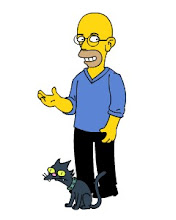 First of all, it's not an entirely conventional documentary. Instead, while using a range of disparate contemporary footage, it links this all together within the framing device of the ruminations of a future archivist. The year is 2055, and the archivist lives in a giant tower in the ice-free waters of the Arctic, guarding over the biological and cultural treasures of the world but isolated from the rest of the otherwise ruined Earth. The archivist asks the simple question: why, given all we knew about future climate change, did we persist with "business as usual"? Splicing together a montage of footage made from a handful of stories from around the world, the archivist attempts to find the answer.
First of all, it's not an entirely conventional documentary. Instead, while using a range of disparate contemporary footage, it links this all together within the framing device of the ruminations of a future archivist. The year is 2055, and the archivist lives in a giant tower in the ice-free waters of the Arctic, guarding over the biological and cultural treasures of the world but isolated from the rest of the otherwise ruined Earth. The archivist asks the simple question: why, given all we knew about future climate change, did we persist with "business as usual"? Splicing together a montage of footage made from a handful of stories from around the world, the archivist attempts to find the answer.When I first heard about this film and, in particular, its use of a futuristic framing device, my heart sank. Another climate change documentary, made "audience-friendly" by a stupid Mad Max setting. However, I hadn't banked on my love for things science fiction, and for the frame's ability to tie the disparate, but personal, documentary stories together. It might seem more obvious to take in the bigger picture, or focus on stories that were more obviously linked, but this would have lost the people in the stories, or would likely have come across as overly contorted and contrived.
The documentary footage ranges over French glaciers, windswept Bedfordshire fields, poisoned African villages, an Indian EasyJet knock-off, a ravaged Middle East and unreconstructed, post-Katrina New Orleans. The stories shown touch on an eclectic mix of climate-relevant topics, shown through the prisms of very different lives. Among other tales, Katrina is viewed by a oil industry geologist gradually awakening from denial. The changing seasons are melancholically described by an aged mountain guide. "Business as usual" is vividly evoked by an at times bullying airline entrepreneur. And solid British NIMBYism is shown confronting and defeating the best efforts of a wind turbine businessman.
While I'm aware that some of my party thought these stories were a bit disjointed, I thought that their diversity, with its strong human angle, was actually a strength. And the framing device actually worked as very successful glue at keeping together what would otherwise have been difficult strands to juggle. But, then, I am a sucker for science fiction.
My main concern with the film was that I'm fearful it'll just preach to the choir. Generalising and stereotyping wildly, last night's audience certainly looked like the choir for sure. That said, by taking such a different tack to Al Gore's more straight-laced effort, it improves its chances of reaching a different audience and broadening the public's understanding of climate change.
Actually, that said, it's not exactly the most positive of films. While it's peppered with upbeat and hopeful messages, the stories told are frequently rather downbeat, and the apocalyptic nature of the framing device doesn't help on this point. In fact, I actually really enjoyed the short portion of the film which details the descent of the present day to a desperate future. There's something about destroying the world that's hard to resist revelling in [*]. Or perhaps that's just me?
While I don't expect it to change the world, I'd certainly recommend it to my friends in the vein of a constant drip-feed of climate change awareness. I'm conscious that our efforts are pitifully slow, but films like this can only collectively help.
Of course, I say all that, but am already scheduled for two flights (one trans-Atlantic) this year. Paraphrasing Hardin, with friends like me, the environment needs no enemies!
[*] Although describing the end of civilisation, surely a bad thing, the film makers put a few really good gags in this rather vigorous section of the film. Among the best were the news story that New Orleans was not going to be rebuilt after its third flooding, and a well-deserved passing shot at Channel 4 who, in an overheated 2030, were putting on a documentary questioning climate change.





.png)


No comments:
Post a Comment